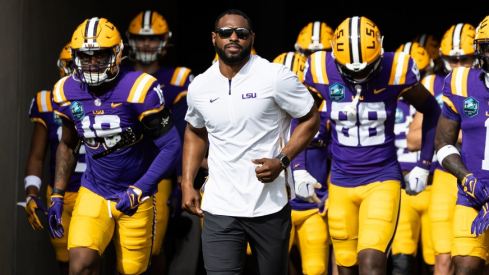
No opponent looms larger for Ohio State then the Michigan Wolverines.
All eyes turn towards the annual grudge match the last weekend in November, and for good reason. The two schools have been slugging it out – often with huge ramifications – for over a century.
With both schools soon to join the new "East" division of the Big Ten in 2014, this could be the only year where the Buckeyes and Wolverines square off twice. It is therefore worthwhile to examine Michigan's schemes, starting with the Wolverine defense.
The Key Cog
In just two seasons in Ann Arbor, Brady Hoke has already worked a minor miracle, reversing the funk accumulated during the Rich Rodriguez era. Hoke's early on-field and recruiting successes and refusal to say "Ohio State" have all added heat to what had become a one-sided rivalry. Theatrics aside, Hoke's most important decision since he became Michigan's head coach was his hire of Greg Mattison as defensive coordinator.
Mattison is not only a great recruiter – Urban Meyer says he's one of the best he has ever seen – but he is a coach that consistently gets the best out of his players.
Mattison's scheme is relatively straightforward. Michigan bases from a 4-3 under defense with their front set to the wide side of the field. When faced with a spread team using three or four wide receivers, Mattison often does not bring in a nickel defender but instead walks his Sam (strong-side) linebacker out over the slot receiver, as demonstrated below.

The primary focus in first and second down is run support. The walked-out Sam linebacker will often cheat off the slot receiver to apply an additional run defender. Michigan will generally play cover-1 "robber" or cover-4 to involve their secondary against the run.
These coverages allow one or both safeties to quickly come downhill when they see run.
Sittin' Back...Or going for Broke
Mattison's goal through aggressive run support is to get the opposing offense into third-and-long situations. He can then seek to keep the offense and its quarterback off-balance by mixing and matching conservative coverages one play with aggressive blitz packages the next.
Specifically, Mattison will mix and match zone defenses such as cover-2 or cover-3 with "psycho" blitz packages. With the latter, the defense will stand up and amass around the line of scrimmage, trying to confuse the offense as to where rushers are coming from before using some form of a zone blitz.
Playin' Fast
The simplicity of Mattison's scheme belies its effectiveness. Mattison was able to take largely the same defensive unit that was the primary cause of Rodriguez's demise and quickly turn them into one the Big Ten's best. He did so by ensuring that his defenders are fundamentally sound through taking proper angles and form tackling.
Mattison's scheme also allows his unit to play aggressively. Whether it is bringing additional defenders against the run or attacking the quarterback, he's betting that his defense can make a play before an offense can exploit openings. Most college quarterbacks cannot successfully stand in the face of unblocked rushers and consistently deliver the football.
Mattison – and Michigan's – goal is to force the opposing offense to make mistakes while allowing his defenders to play aggressively and build confidence. The Michigan defense versus Urban Meyer's Buckeye offense will be a battle of strength-versus-strength in the years ahead.

